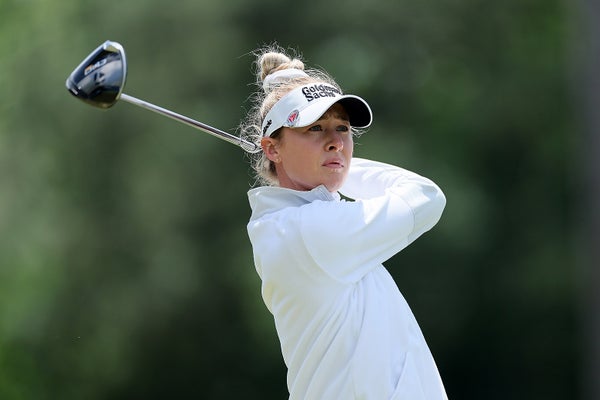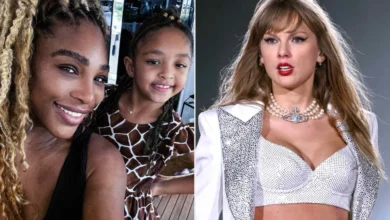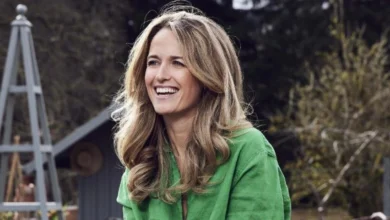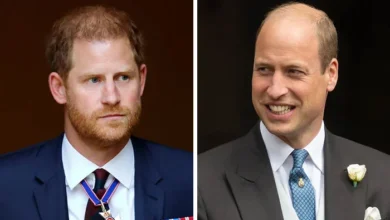
Nelly Korda is on the heater of a lifetime. The best player in women’s golf has won five tournaments in a row going back to late January, the most recent of those at the season’s first major, the Chevron Championship, in mid-April. That ties her with Annika Sörenstam and Nancy Lopez for the longest streak in women’s golf history.
Korda is so scalding that before this week’s Cognizant Founders Cup in New Jersey, she took a few weeks to cool off. Now, she’ll try to make the record all her own. While doing all that winning, Korda has generated tons of golf buzz. The galleries following her at her last event were huge by the standards of any non–Tiger Woods player. It’s less clear that people who aren’t already women’s golf fans are tuning in. TV viewership for that last event, a major, was basically flat from the year prior.
Beyond mere excellence, Korda has a lot in common with newly minted No. 1 WNBA draftee Caitlin Clark. While Clark plays an electric style of basketball that translates perfectly to a vertical video app, Korda has the most impressive swing in golf.
For years, her move to the ball has been Instagram and YouTube catnip for golfers of all genders, a once-in-a-generation mix of relaxed tempo, flexibility, and speed. Korda, just 25, is a sought-after pitchwoman just like Clark. Both have lengthy lists of blue-chip sponsors.
They have shared at least one: Goldman Sachs, which put Clark in a commercial during the 2023 NCAA tournament and has its name on Korda’s visor as she plays. Both players have seen their fame and performance hit a crescendo lately, but both have been huge figures in their sport since 2021, the year Clark wrapped her freshman season at Iowa and Korda reached No. 1 in the world and won Olympic gold
Where the comparison ends is that every American sports fan (and beyond) knows Clark, but most do not know Korda. The reasons for that discrepancy are outside the golfer’s control. Korda plays a sport that isn’t naturally given to making her a huge deal outside its walls, and those walls are high. Golf is an inconvenient and expensive game to play, and the women’s pro game is a hard one to find, as a spectator.
Korda is also dominant in a moment when it’s not clear how much dominance sells. She will win many more tournaments, but it remains to be seen if she can elevate something that doesn’t want to be elevated. If not, you can at least make yourself a more fulfilled sports fan by finding her rounds and watching them.
The story of Clark’s cultural preeminence this spring has also been the story of women’s basketball’s rise. The star player and the rest of the sport were good for each other. Clark was undeniably compelling, and she came around at a time when the sport’s popularity was growing and when NCAA economics were shifting in women’s favor.
The embrace of the sport by media companies was key, as several Clark games got network TV placement. Seeing the rising tide, ESPN marshaled its agenda-setting ability to drive more attention to the sport and the player. That meant everything from putting together a robust studio crew to having big names like Stephen A. Smith debate Clark’s legacy in real time.
None of that is happening in women’s golf. NBC aired the last few hours of the action on Saturday and Sunday, as Korda wrapped her fifth straight win. But most of her rounds are on Golf Channel or a streaming product, and many tournaments don’t make it onto network TV at all.
(The standard for men’s tournaments is cable and streaming on Thursday and Friday, then network on long weekend afternoons.) This weekend, as Korda tries for her sixth win in a row, all four rounds are not just relegated to cable but to a tape delay, airing in the evenings while a (men’s) PGA Tour event takes the slot during the day.
Otherwise the only way to watch her will be on ESPN+, the Disney service that has just 25 million subscribers, about 100 million fewer than the number of households that have network television. The rest of the golfing press has by no means ignored Korda.
She is a conversation topic all the time in a bunch of golf magazines and podcasts, and she is all over TaylorMade’s equipment advertising. But that is just the thing: Golf fans are well acquainted with her. Generalist sports fans are not.
We need a stage,” Korda said after her last win. “We need to be on prime-time TV.” Eventually, the sport should get bigger support from networks. Any media executive with any familiarity with recent trends in the sports business should be interested in taking more of a stab at women’s golf. The best way to showcase Korda is simply to have more people watch her play golf, and at the moment, the suits are not helping.
And even when that changes, a TV network won’t do the job alone. Golf is the favorite sport of 1 percent of the country, which is different from being the 1 percent’s favorite sport, but only so much. All due respect to the people working hard to make the game accessible to more people, but golf is also on the shortlist of Earth’s least progressive sports.
It is a country club game steeped in conservative tradition and politics. That materializes in different ways at different times. Lately, you may have noticed the Saudi Arabian government attempting to lease the federal government’s executive branch from 2025 to 2028 by holding golf tournaments at Trump courses.
Golf is far from the only sport to have some cold, hard commercial arrangements. But it might be the least inclined to rally support for women’s competition in a way that has mainstream appeal. In soccer, the growth of the U.S. women’s national team into a cultural behemoth has been partly down to how great the team has been. But the USWNT has also positioned itself as a cause worth supporting—in a fight with the national federation and for LGBTQ+ inclusion and women’s rights. College basketball is somewhat similar.
The caliber of play is excellent, some of the schools have rabid fanbases built in, and watching the sport fits with a belief that women’s sports have gotten short shrift over the decades and deserve a chance to shine. The second-class treatment of the women’s tournament not only made the NCAA look foolish but offered up a wrong for sponsors, fans, and media partners to right.



